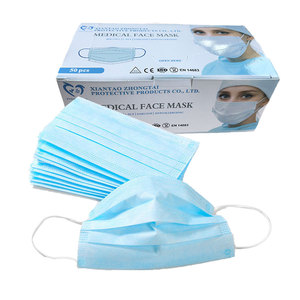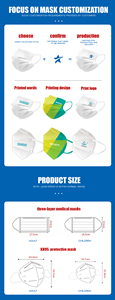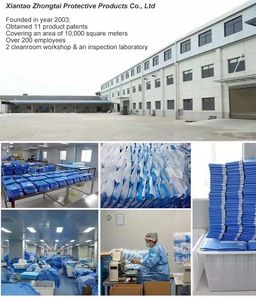(1947 products available)
































































































































































































































In addition to black surgical masks, there are other types of medical masks that serve different purposes in healthcare and beyond.
Basic Medical Masks
These are typically used in situations where the risk of infection is low. They help offer a basic level of protection by preventing large droplet inhalation. Hospitals use medical masks in non-surgical, low-risk patient care settings. There are also medical masks available in various colors, which can be less clinical in appearance but still offer the same level of protective function.
N95 Respirators
N95 respirators are designed to filter at least 95% of airborne particles, including small particles. This makes them more effective than surgical masks at providing protection against infectious aerosols. They are commonly used in situations where healthcare workers face exposure to patients with respiratory infections. N95s are essential during disease outbreaks and in procedures that generate respiratory droplets.
Other Surgical Masks
Aside from the popular black ones, surgical masks come in different colors and designs, too. These masks are worn during surgeries and procedures where there will be blood or other body fluid splashes. They protect both the patient from the healthcare worker and the healthcare worker from the patient. There are also surgical masks with extra features like fluid resistance for added protection in high-risk environments.
Hybrid Masks
Hybrid masks combine the traits of surgical masks and respirators, aiming for better comfort and protection in single-use medical contexts. These masks often have a tighter fit, more layers, and better filtration than regular surgical masks but are more breathable than N95s. Their design makes them useful during lengthy procedures requiring a respirator or surgical mask in most settings.
Specialty Masks
There are also surgical masks with features that serve a purpose, such as masks with powered air-purifying respirators. These are for use in environments where there are chemical or particulate hazards. Also, anti-fog surgical masks are designed for use in situations where health workers must wear protective eyewear, such as during surgery. Those with antimicrobial properties are intended to reduce the risk of infection in patients who are at greater risk.
Aside from the plain surgical masks, the mask design has evolved over the years. What was a plain and simple mask now comes with various innovations.
3D and Contour Designs
The 3D design is developed such that when it is worn, the mask sits away from the mouth and nose, giving more space for easier breathing and speaking. This design offers a better fit around the nose, cheeks, and jaw. Because of this, 3D masks are more comfortable for long-term use. This design is also better at keeping makeup or moisture from transferring to the mask.
Ventilated Masks
This medical mask design has small valves or vents that make it easier to breathe, particularly for those who find it hard to get enough air through standard medical masks. The vents allow exhaled breath to escape more easily, reducing heat and moisture buildup inside the mask. This kind of design is particularly useful during long procedures or in hot environments. However, ventilated masks are not typically used in black surgical mask requirements because they do not filter exhaled breaths.
Engineered Fit Masks
These masks have tested several designs to improve their fit to different face shapes and sizes. There are also more adjustable features around the ears and the nose. The goal of this design is to minimize gaps along the edges that reduce filtering effectiveness. What sets them apart is the use of data obtained through 3D imaging and scanning to identify the most common face shapes for the prototypes.
Integrated Shield Masks
This type of medical mask combines the mask with a protective face shield. It is meant to provide both respiratory protection and splash and droplet hazard. Integrated shield masks are used in situations such as surgery where both blood or fluid splashes and aerosol transmission are risks. Health workers do not have to rely on separate eye protection.
Smart Masks
Advances in materials science and wearable technology make it possible to incorporate sensors into medical masks. These so-called smart masks can monitor vital signs, detect pathogens in the environment, or check the quality of breathing. Some models also have active filtering systems that can respond to changes in air quality. There is even one being developed with built-in Bluetooth technology so one can connect with a mobile app to provide real-time data and alerts.
Ever since the pandemic started, the demand and need for medical masks shot through the roof. So did the need for people to invest in medical masks and the business opportunities it presents.
Infection Prevention
So much value is placed in medical masks because they are important in controlling the spread of infections in healthcare and community settings. Medical masks act as barriers to blood, fluids, and germs, reducing the risk of diseases like influenza and COVID-19 by preventing droplets from entering the mouth or nose. Their use in surgeries, procedures, and examinations is crucial for patient safety.
Increased Demand
The emergence of global health crises like the pandemic increased the demand for medical masks. There was heightened awareness of disease prevention and the need for personal protective equipment. Because of this, there was a surge in both consumer and industrial sectors, inspiring companies to create and expand their production capabilities just to meet this demand.
Health and Safety Regulations
Governments and health authorities all over the world have requirements and guidelines that mandate the use of medical masks, specifically in healthcare settings and public transportation venues. Compliance with these regulations has driven up the consumption of medical masks, making them a business necessity and increasing public awareness of their importance.
Improved Mask Designs
People discovered the commercial value of innovation in medical mask design, especially with the introduction of more functional and simpler masks. From N95 respirators to surgical masks to medical reusable masks and face shields, there is a variety of protective equipment. The emergence of stylish and comfortable masks widened their market appeal further.
Market Opportunities
Medical masks being in demand makes it a lucrative business opportunity. There is a still growing need for PPE and medical devices to be produced in bulk so that people can protect themselves during this health crisis. There is also a chance for one to pursue sustainability in business because there are now eco-friendly materials available.
Collaboration with Healthcare Industry
To address the increasing demand for medical masks, many companies collaborated with the healthcare industry during the pandemic. This relation helps boost one's business, as does working with hospitals and clinics to provide PPE. Having such close ties creates a niche for businesses within the larger healthcare ecosystem.
There are some factors one has to consider to enjoy the full benefits of medical masks and to do its objective of protecting people.
Filtration Efficiency
Medical masks must have high-quality filters. People have to look for masks that can block or filter at least 95% of small airborne particles. Medical masks have to use advanced materials to ensure that more infectious aerosols are trapped while allowing the wearer to breathe more easily.
Comfort and Fit
Comfort is key, especially when the mask has to be worn constantly during surgery or procedures. One has to look for masks with adjustable nosepieces and elastic ear loops for a good fit without leaving any gap. This will ensure that the mask provides protection while not being too comfortable and easy to take off.
Fluid Resistance
In medical settings, exposure to blood or other body fluids is always a possibility. Choosing surgical masks with fluid-resistant properties is critical to performing procedures safely. These masks are made of materials that repel liquid droplets to minimize splashing hazards. Fluid resistance keeps the mask intact during wet procedures and helps protect the wearer from potential infections.
Breathe Through Ability
Sufficient airflow is needed in medical masks to ensure the wearer does not tire out quickly with constant use. It is, therefore, important to choose a mask in which air can pass through with less effort. When air does not pass easily through the mask, the wearer will struggle to get enough air, leading to discomfort and dangerous levels of oxygen deprivation, especially when one has to wear the mask for long periods. Good breathable medical masks allow endurance use without sacrificing comfort or safety. Some masks have ventilation.
Regulatory Compliance
When it comes to choosing a medical mask, the manufacturer and the mask itself must meet stringent medical standards and certifications. These requirements differ from one country to another. One has to verify that the mask complies with all PPE regulations and certifications established by local health authorities. Businesses can therefore ensure that the mask delivers quality protection in whatever environment it is used in by selecting one certified as compliant.
Sourcing and Supply Consistency
Especially in a crisis, the consistent availability of medical masks is essential in situations where there is constantly a demand for PPE. Medical masks are to be sourced from suppliers that can guarantee continuity in bulk supply without interruption. Consistency in supply chain management means organizations can meet the always-needed demand for masks today and tomorrrow.
A surgical mask is made specifically to cover a person's mouth and nose during surgery to prevent infection and contamination, while a medical facial mask is used by doctors, nurses, and patients to control the spread of infectious diseases. Medical masks are meant to be used in certain medical environments and situations, but cloth facial masks are not and have more uses outside of the medical field.
Black surgical masks are as effective as any ordinary surgical mask. As long as they have the essential three layers that an ordinary surgical mask has - the inner layer for moisture absorption, the middle layer for filtration, and the outer layer for protection - black surgical masks can be as effective against bacteria and virus compared to white surgical masks.
These two masks differ in that medical masks are designed to reduce the risk of infection in patients in a healthcare environment, while surgical masks are made for use in surgery and are more strictly regulated in terms of their filtration and fluid resistance capabilities. In short, all surgical masks are medical masks, but not all medical masks are surgical masks.
The black surgical mask has three layers like any other surgical mask. The outer layer is the defense against water droplets and harmful particles and is made from a water-resistant fabric. The middle layer is a filter that blocks bacteria, viruses, and other small particles. It is made of non-woven material that provides electrostatic attraction. Finally, the inner layer is a moisture-absorbing fabric that allows the wearer to breathe without discomfort while keeping the mask dry.
Surgical masks are meant to be disposable, and one should wear them for no more than 8 hours in healthcare settings. It is even more ideal for changing the mask every 4 hours of continuous use. That, though, is for people wearing these masks in hospitals. For others who use it daily to go to places like the market or public transportation, it's ideal to replace it every 3 to 4 days, as long as it doesn't get wet or soiled. To maintain optimum protection, it's essential to change worn masks.